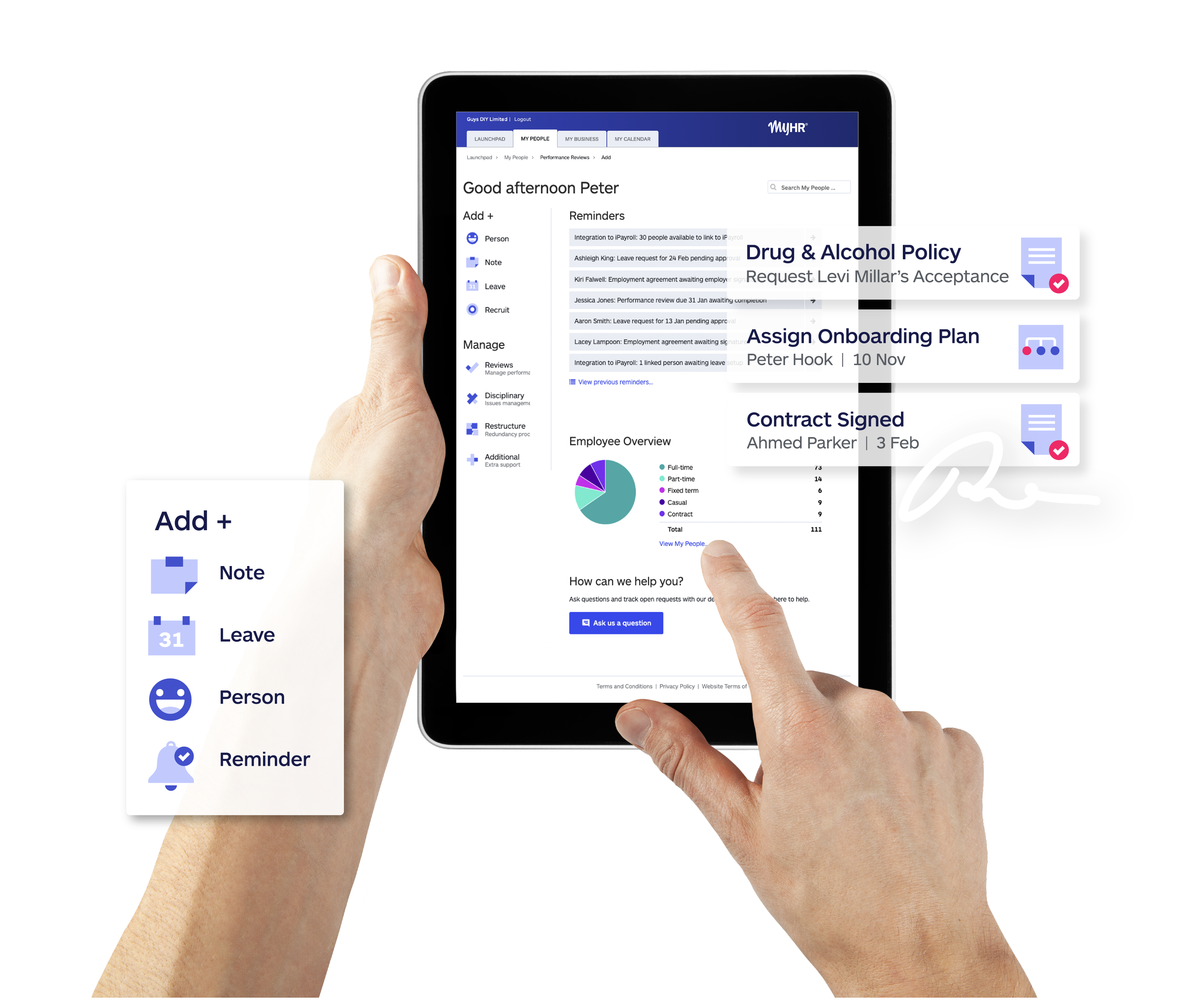As an employer, you need to understand what leave your employees are entitled to under the National Employment Standards (NES), and what requirements and responsibilities employees have when applying for and taking leave from work.
To make it easy, we created this guide that breaks down the types of employee leave entitlements and their conditions.
Annual leave
Annual leave (also known as holiday pay) is when the employer pays an employee for time taken off work.
Full-time and part-time workers are entitled to 4 weeks of annual leave for every 12 months worked. Leave is based on the employee’s ordinary hours of work and paid at their base pay rate.
A modern award, registered agreement, or employment contract can provide more annual leave (and a different method of payment or entitlement to annual leave loading) but can't offer less than the NES minimum.
Annual leave starts accumulating from an employee’s first day at work and they can take leave as soon as they accumulate it.
There is no maximum or minimum period of annual leave that a worker can take. If any leave isn’t used, it rolls over to the following year.
Casual employees do not get annual leave.
Typically, employers and employees come to an agreement about when they take annual leave and for how long, unless there are requirements for directing, granting, and taking leave in the applicable award or registered agreement.
An employer cannot unreasonably refuse a worker’s annual leave request.
Public holidays
There are 7 national public holidays in Australia: New Year's Day, Australia Day, Good Friday (Easter Friday), Easter Monday, Anzac Day, King's Birthday, Christmas Day and Boxing Day.
States and territories also have their own additional public holidays, e.g. Western Australia Day, Melbourne Cup Day (Victoria), Picnic Day (Northern Territory).
Holidays that fall on weekends are generally observed on the Monday after the holiday.
Depending on the terms of the modern award, registered agreement or employment contract, employees who work on a public holiday could be entitled to one of the following:
- Public holiday pay rate.
- An extra day off or additional annual leave.
- Minimum shift lengths on public holidays.
- Substituting a public holiday for another day.
All employees have a right not to work on public holidays; however, employers can ask them to work if the request is reasonable. Employees, in turn, can refuse it if they have their own reasonable grounds.
An employee doesn't get paid for a public holiday if they don't usually work on the day that the public holiday falls on.
Read our article on understanding public holidays and what to pay workers.
Parental leave
Unpaid parental leave / adoption leave
Unpaid parental / adoption leave is available to full-time, part-time, and eligible casual employees who, or whose spouse or de facto partner experience the birth of, or adoption of, a child or children.
Under the NES, access to unpaid parental / adoption leave is conditional on an employee being responsible for the care of the child and having completed at least 12 months’ regular, systematic and continuous service with their employer
Employees get 12 months of unpaid parental leave. They can also ask for up to another 12 months of leave.
To be eligible, employees must have worked for an employer for 12 months before the baby is born (or before the date of the adoption) and be responsible for the care of the child. Casual employees are eligible once they have been working for the employer on a regular basis for 12 months and have a reasonable expectation of this regular work continuing.
Any period of unpaid leave which has been taken by an employee (including any period of unpaid special parental leave leading up to the unpaid parental leave period) will not count as continuous service for the purpose of calculating the 12-month qualifying period for access to unpaid parental/adoption leave.
Paid parental leave
Employees may be entitled to paid parental leave under the federal government’s Parental Leave Pay scheme.
For a child born or adopted before 1 July 2023, parents can get up to 18 weeks pay.
After 1 July 2023, the maximum paid leave will increase depending on when the child was born or adopted, from 20 weeks up to 26 weeks (after 1 July 2026).
To be eligible, employees have to meet work and income tests.
Employees may have other parental leave entitlements under a modern award, registered agreement, their employment contract or company policy.
Personal leave (also known as sick and carer’s leave)
Full-time and part-time employees can take paid sick or carer’s leave (also known as personal leave). Sick and carer's leave lets an employee take time off to deal with:
- personal illness or injury
- caring responsibilities
- family emergencies.
Full-time and part-time employees’ yearly entitlement of paid sick or carer’s leave depends on their ordinary hours of work. Full-time employees are entitled to 10 days and any unused sick leave carries over to the following year.
Casual employees and contractors do not get paid sick or carer’s leave but can access unpaid carer’s leave.
Employees need to notify the employer as soon as they can that they intend to take sick leave (even if this is after the leave has started), and should also specify how long they expect to be off work for, if possible.
Employees can also take an extended period of unpaid sick leave. The Fair Work Ombudsman has more information on long periods of sick leave.
Asking for evidence for sick and carer’s leave
You can ask an employee for evidence showing why they were away from work. An award, agreement or your business’s policies might specify when employees need this evidence.
Medical certificates and statutory declarations are examples of acceptable evidence. Evidence doesn’t have to include exact details about the injury or illness.
Our post on managing sick leave has more information for employers.
Family and domestic violence leave in Australia
All employees (including part-time and casual employees) can access 10 days of paid domestic and family violence leave each year.
Employees can access all 10 days as soon as they start work. The entitlement resets on their work anniversary and does not accumulate from year to year.
Employees taking domestic and family violence leave have to let their employer know as soon as possible (even if this is after the leave has started) and should say how long they expect the leave to last.
You can ask the employee for evidence that shows they took the leave to deal with family and domestic violence. The evidence needs to convince a “reasonable person” that the person took the leave to deal with the impacts of family and domestic violence and it’s not practical for them to do so outside work hours.
Community service leave
Employees can take community service leave for paid jury duty or voluntary (unpaid) emergency management activities. An employee is considered to be part of voluntary emergency management if:
- The activity provides relief in an emergency or natural disaster.
- The employee’s participation is voluntary.
- They were asked to help (or would have been asked to do so if circumstances allowed).
- The employee is a member of or is associated with a recognised emergency management body.
There is no limit on the amount of community service leave employees can take. They are entitled to take the leave while they are engaged in the activity and for reasonable travel and rest time.
Employees must let the employer know, as soon as possible, that they intend to take community service leave and should also say how long they expect to be away from work.
You can request that the employee provide evidence that they're entitled to community service leave.
Long service leave entitlements by state
Employees who have spent between 5-10 years with the same company are entitled to paid long service leave that varies from 2 to 3 months, depending on the state or territory:
- Australian Capital Territory - 6.066 weeks on full pay after each period of 7 years of continuous service.
- New South Wales - 2 months (8.67 weeks) paid leave after ten years' continuous service. One month leave for each subsequent five years of continuous service. The legislation also provides for a pro-rata entitlement after five years, if the employer has terminated an employee's employment for any reason other than serious and wilful misconduct, or if the employee dies.
- Northern Territory - 13 weeks on full pay after each period of 10 years of continuous service.
- Queensland - 8.6667 weeks on full pay after each period of 10 years of continuous service. The legislation also provides for a pro-rata payment on termination (subject to criteria) between 7 and 10 years of continuous service.
- South Australia - 13 weeks on full pay after each period of 10 years of continuous service. The legislation also provides for a pro-rata payment on termination (subject to criteria) after seven years of continuous service.
- Tasmania - 8⅔ weeks paid leave after completing ten years of continuous employment and 4⅓ weeks of leave after each additional five years of continuous work
- Victoria - accrues at a rate of one week for every 60 weeks of continuous employment (approximately 0.866 weeks per year), and can be taken any time after seven years' continuous service.
- Western Australia - 8.667 weeks on full pay after each period of 10 years of continuous service. The legislation also provides for a pro-rata payment on termination (subject to criteria) after seven years of continuous service.
When an employee ends employment and they have worked the minimum service period, they are entitled to be paid the amount of unused leave entitlement (on a pro-rata basis).
Compassionate leave (also known as bereavement leave)
Employees are entitled to 2 days compassionate leave for each instance if:
- A member of their immediate family or household dies, or contracts or develops a life-threatening illness or injury.
- A baby in their immediate family or household is stillborn.
- They have a miscarriage, or their current spouse or de facto partner has a miscarriage.
Employees can take compassionate leave as:
- A single continuous 2 day period.
- 2 separate periods of 1 day each.
- Any separate periods as agreed with their employer.
Employees don't accumulate compassionate leave and it's not a part of their sick and carer's leave entitlement. Employees can take compassionate leave any time they need it.
If an employee is already on another type of leave and needs to take compassionate leave, they can use compassionate leave instead of the other leave.
Workers compensation
Employees with work-related injuries may be eligible for payments under their employer's workers' compensation schemes.
All employers must have workers compensation insurance for their Australian employees.
Find out more about workers compensation at fairwork.gov.au.
Using a leave management platform to track employee leave
Don’t take chances with your employee leave entitlements. Utilising a leave management platform makes tracking, approving, and paying leave much easier while significantly reducing room for errors.
MyHR provides a seamless, integrated solution for all of your organisation’s leave and time-off functions.
Automate your leave and payroll processes, so you can be sure leave is accurately calculated and every worker is paid correctly and on time, without having to double-handle data. Track leave balances, approve requests, and view team availability alongside key dates in one shared calendar.



